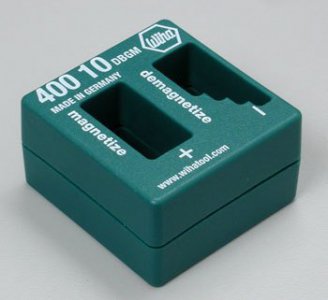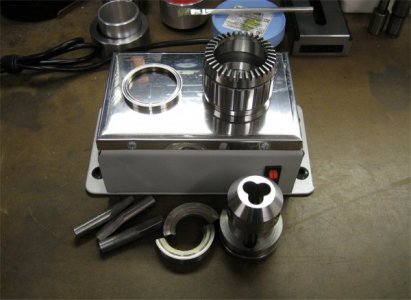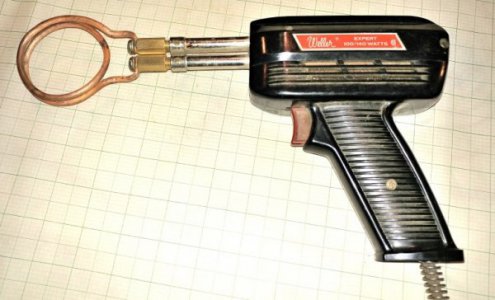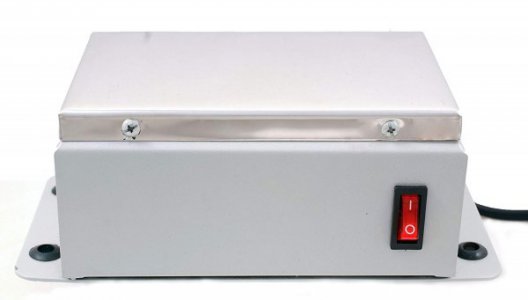I got it for $40 shipped. I thought that was pretty good.kev74:
https://www.ebay.com/itm/L-W-Demagnetizer-L-W-Chuck-Co-Bench-Top-Demagnetizer-110-Volt-60-Cycle-A-C/232999642527?ssPageName=STRK:MEBIDX:IT&_trksid=p2057872.m2749.l2649
Wowsers! Shipping's gonna get ya on this one!
-
Welcome back Guest! Did you know you can mentor other members here at H-M? If not, please check out our Relaunch of Hobby Machinist Mentoring Program!
You are using an out of date browser. It may not display this or other websites correctly.
You should upgrade or use an alternative browser.
You should upgrade or use an alternative browser.
Demagnetizing tools
- Thread starter Tozguy
- Start date
- Joined
- Nov 18, 2012
- Messages
- 1,352
David,
I've got one of those big soldering guns. What gage wire did you use? Is the number of wraps critical?
I used insulated 18 awg and 6 turns around an old plastic form.
David
- Joined
- Nov 27, 2012
- Messages
- 7,912
I have this demagnetizer
https://www.jensentools.com/general-3601-magnetizer-demagnetizer/p/424-597
that I am trying to use to demagnetize some Allen keys. I follow the instructions but can't get rid of the magnetization.
It would be interesting to learn how they get magnetized unintentionally so it could be avoided but till then I would like to be able to demagnetize when needed.
Is this the right tool? Can I expect to remove the magnetization completely using this tool?
Thanks.
I've got 4 of the older Wiha demagnatizers (older ones were dark green, new ones are mint green) that works well. I use them on screwdrivers & stuff like that. I did have a cheap generic one that looked like the Wihas but it didn't work very good at all so I gave it away.

I also have a unit that I got from Enco for $30. It's an import but it works very well. I've even demagntized my digital calipers with it.

- Joined
- Feb 1, 2015
- Messages
- 9,974
Pure iron and low carbon steel generally don't become magnetized. Unfortunately, the tool steel we use has carbon and is susceptible. The magnetic domains in steel are normally randomly oriented so the net alignment is zero and the steel is not magnetized. When a magnet is brought near, the domains align along the magnetic field line produced by the magnet. (Visualize some iron filings brought near a magnet. The filings will align themselves in more or less parallel strings going from one pole of the magnet to the other.)
If the magnet is suddenly pulled away from the steel, the domains retain the alignment and the steel is magnetized. As a youngster, I used to stoke a sewing needle to magnetize it and if it were placed on a cork in a bowl of water, it would become a compass. Magnetic fields fall off rather quickly as the distance from the magnet increases. Doubling the distance will reduce the field strength to 1/8th.
Years ago, magnets were fairly weak. The rare earth magnets that surround us in our daily live are much stronger. The act of casually bringing a piece of steel near one of these is sufficient to magnetize the steel. The magnetic fields created by coils of wire carrying current can also magnetize steel if the current is suddenly switched off. Using the indicator stands with magnetic bases is another good way to unintentionally magnetize steel.
Steel can be demagnetized by placing in an oscillating magnetic field and slowly withdrawing it. The oscillations can be done by applying an alternating current to a coil of wire. The strength of the field created is proportional to the current times the number of turns. This is the method used by many demagnetizers. Another way is using a rotating magnet. I had a cassette tape demagnetizer that just used a bar magnet attached to a small motor. In either case, the magnetized steel is brought into the magnetic field and slowly withdrawn.
I have repurposed on of my soldering guns as a demagnetizer. One interesting point is, since the magnetic field strength is proportional to the current times the number of turns but inversely proportional to the length of the wire, increasing the number of turns didn't increase the magnetic field. For my 140w. gun, I use about 6" of 10AWG wire for soldering tips. Resistance halves for every three AWG wires sizes so a 14" length of 6AWG wire has about the same resistance. I made adapters for the lugs on my soldering gun and flattened and punched eyes in the end of the wire. I annealed and bent it into two 2" i.d. loops. On the 100 watt setting, I pegged the 300 amp range on the 100 watt position my clamp on ammeter so I am probably close to 500 amps on the 140 watt position. At two turns, this gives me 1,000 ampere-turns.
To use, I power the soldering gun and slowly pass the magnetized piece through the coils and pull it away from the coils before releasing the trigger. A single pass is sufficient.

If the magnet is suddenly pulled away from the steel, the domains retain the alignment and the steel is magnetized. As a youngster, I used to stoke a sewing needle to magnetize it and if it were placed on a cork in a bowl of water, it would become a compass. Magnetic fields fall off rather quickly as the distance from the magnet increases. Doubling the distance will reduce the field strength to 1/8th.
Years ago, magnets were fairly weak. The rare earth magnets that surround us in our daily live are much stronger. The act of casually bringing a piece of steel near one of these is sufficient to magnetize the steel. The magnetic fields created by coils of wire carrying current can also magnetize steel if the current is suddenly switched off. Using the indicator stands with magnetic bases is another good way to unintentionally magnetize steel.
Steel can be demagnetized by placing in an oscillating magnetic field and slowly withdrawing it. The oscillations can be done by applying an alternating current to a coil of wire. The strength of the field created is proportional to the current times the number of turns. This is the method used by many demagnetizers. Another way is using a rotating magnet. I had a cassette tape demagnetizer that just used a bar magnet attached to a small motor. In either case, the magnetized steel is brought into the magnetic field and slowly withdrawn.
I have repurposed on of my soldering guns as a demagnetizer. One interesting point is, since the magnetic field strength is proportional to the current times the number of turns but inversely proportional to the length of the wire, increasing the number of turns didn't increase the magnetic field. For my 140w. gun, I use about 6" of 10AWG wire for soldering tips. Resistance halves for every three AWG wires sizes so a 14" length of 6AWG wire has about the same resistance. I made adapters for the lugs on my soldering gun and flattened and punched eyes in the end of the wire. I annealed and bent it into two 2" i.d. loops. On the 100 watt setting, I pegged the 300 amp range on the 100 watt position my clamp on ammeter so I am probably close to 500 amps on the 140 watt position. At two turns, this gives me 1,000 ampere-turns.
To use, I power the soldering gun and slowly pass the magnetized piece through the coils and pull it away from the coils before releasing the trigger. A single pass is sufficient.

- Joined
- Feb 13, 2017
- Messages
- 2,138
The type of work I do (especially computers), I find magnetized tools to be a nuisance. Most of my problems are with smaller tools. And very small, for model building. I have a Weller D-550, pictured above, hanging on my bench.
For my stuff, so small, it works with a soldering tip. Using 12 AWG, or even 10 AWG, to make a larger loop should work as needed. I have been using this technique for at least 30 years, maybe longer but I don't remember for sure. It does require withdrawing the tool from the field a couple of times, but compared to a "Demag Tool", the cost is insignificant. The soldering iron is there for soldering anyway. Just an added reason to have it handy..
The transformer in the soldering "gun" is a fairly low duty cycle, not 100% by any means. But having the tool touch the copper is not important, as there's only a volt or two there. Very high current, low voltage. Most of the tools I use it onj are small enough to use the soldering tip.
For what it's worth, I also use a Weller 8200 on remote work. 100/140 watt... I use AWG 14 for a soldering tip. It doesn't last near as long as a proper tip, but it's cheap. And just as fast to install.
For my stuff, so small, it works with a soldering tip. Using 12 AWG, or even 10 AWG, to make a larger loop should work as needed. I have been using this technique for at least 30 years, maybe longer but I don't remember for sure. It does require withdrawing the tool from the field a couple of times, but compared to a "Demag Tool", the cost is insignificant. The soldering iron is there for soldering anyway. Just an added reason to have it handy..
The transformer in the soldering "gun" is a fairly low duty cycle, not 100% by any means. But having the tool touch the copper is not important, as there's only a volt or two there. Very high current, low voltage. Most of the tools I use it onj are small enough to use the soldering tip.
For what it's worth, I also use a Weller 8200 on remote work. 100/140 watt... I use AWG 14 for a soldering tip. It doesn't last near as long as a proper tip, but it's cheap. And just as fast to install.
Bill Hudson
I just pulled an old 110v ac motor I had recently tossed in the trash back out of the trash and removed the insides to make a demagnetizer today. It creates a crazy powerful magnet though and is quite difficult to pull anything through. I found that holding the item in the center of the windings, pushing the button to power it up while at the same time yanking the part out works best. If anyone knows how I could tone down the power of the magnet i am all ears. On the other hand it demagnetizes them perfectly. Not even the finest of steel chips stick to my calipers or files anymore.
- Joined
- Jul 2, 2014
- Messages
- 7,594
Less voltage is about all you can do. Perhaps a variac or other voltage reducer.I just pulled an old 110v ac motor I had recently tossed in the trash back out of the trash and removed the insides to make a demagnetizer today. It creates a crazy powerful magnet though and is quite difficult to pull anything through. I found that holding the item in the center of the windings, pushing the button to power it up while at the same time yanking the part out works best. If anyone knows how I could tone down the power of the magnet i am all ears. On the other hand it demagnetizes them perfectly. Not even the finest of steel chips stick to my calipers or files anymore.
- Joined
- Dec 26, 2016
- Messages
- 2,106
I tried the small type in the OP's post and could not get it to work properly , it looked like it only demagnetized smaller screwdrivers and only when it didn't touch the sides/body of the demagnetizer, so I bought a bigger economy size that Will (D-ZERO) posted and it does what's supposed to do and does it well, magnetized tools are real pain most of the time but it is hard to justify the cost of buying a HD demagnetizer only to use it once in a while , overall I have no regrets having one in my shop ,to me it is money well spent.


If magnetic field strength is proportional to current x no of winds, you need to increase voltage with a transformer. Current and voltage are inversely proportional - if you increase voltage you decrease current.I just pulled an old 110v ac motor I had recently tossed in the trash back out of the trash and removed the insides to make a demagnetizer today. It creates a crazy powerful magnet though and is quite difficult to pull anything through. I found that holding the item in the center of the windings, pushing the button to power it up while at the same time yanking the part out works best. If anyone knows how I could tone down the power of the magnet i am all ears. On the other hand it demagnetizes them perfectly. Not even the finest of steel chips stick to my calipers or files anymore.
Sent from my H3123 using Tapatalk
